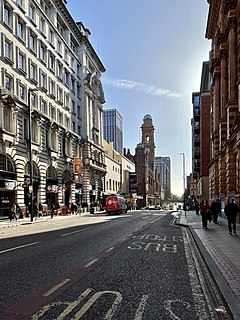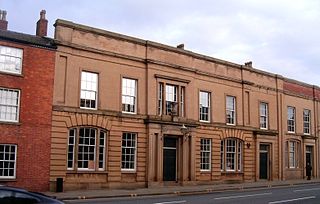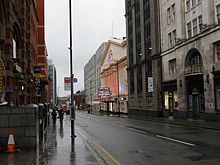
Castlefield is an inner city conservation area in Manchester, North West England. The conservation area which bears its name is bounded by the River Irwell, Quay Street, Deansgate and Chester Road. It was the site of the Roman era fort of Mamucium or Mancunium which gave its name to Manchester. It was the terminus of the Bridgewater Canal, the world's first industrial canal, built in 1764; the oldest canal warehouse opened in 1779. The world's first passenger railway terminated here in 1830, at Liverpool Road railway station and the first railway warehouse opened here in 1831.

Wilmslow Road is a major road in Manchester, England, running from Parrs Wood northwards to Rusholme. There it becomes Oxford Road and the name changes again to Oxford Street when it crosses the River Medlock and reaches the city centre.

Manchester City Centre is the central business district of Manchester in North West England, within the boundaries of Trinity Way, Great Ancoats Street and Whitworth Street. The City Centre ward had a population of 17,861 at the 2011 census.

Granada Studios Tour was an entertainment theme park at the Granada Studios complex in Castlefield, Manchester, England which operated from 1988 to 1999. The park was located in the heart of Manchester city centre adjacent to the Granada House building.

Sunlight House is a Grade II listed building in the art deco style on Quay Street in Manchester, England. Completed in 1932 for Joseph Sunlight, at 14 storeys it was the tallest building in Manchester, and the top floors of turrets and multiple dormer windows and mansard roofs create a distinctive skyline.

Deansgate is a main road through Manchester City Centre, England. It runs roughly north–south in a near straight route through the western part of the city centre and is the longest road in the city centre at over one mile in length.

Beetham Tower is a 47-storey mixed use skyscraper in Manchester, England. Completed in 2006, it is named after its developers, the Beetham Organisation, and was designed by SimpsonHaugh and Partners. The development occupies a sliver of land at the top of Deansgate, hence its elongated plan, and was proposed in July 2003, with construction beginning a year later.

Spinningfields is an area of Manchester city centre, in North West England, developed in the 2000s between Deansgate and the River Irwell by Allied London Properties. The £1.5 billion project consists of twenty new buildings, totalling approximately 430,000 sq metres of commercial, residential and retail space. It takes its name from Spinningfield, a narrow street which ran westwards from Deansgate. In 1968, Spinningfield and the area to the south were turned into Spinningfield Square, an open paved area. The Manchester Civil Justice Centre is a landmark building of the scheme and construction commenced on 1 Spinningfields, a 90-metre office building, in early 2015.

Liverpool Road is a former railway station on the Liverpool and Manchester Railway in Manchester, England that opened on 15 September 1830. The station was the Manchester terminus of the world's first inter-city passenger railway in which all services were hauled by timetabled steam locomotives. It is the world's oldest surviving terminal railway station. With tracks running at a second floor level behind the building, it could also be considered one of the world's first elevated railway stations.

MediaCityUK is a 200-acre (81 ha) mixed-use property development on the banks of the Manchester Ship Canal in Salford, Greater Manchester, England. The project was developed by Peel Media; its principal tenants are media organisations and the Quayside MediaCityUK shopping centre. The land occupied by the development was part of the Port of Manchester and Manchester Docks.

The architecture of Manchester demonstrates a rich variety of architectural styles. The city is a product of the Industrial Revolution and is known as the first modern, industrial city. Manchester is noted for its warehouses, railway viaducts, cotton mills and canals - remnants of its past when the city produced and traded goods. Manchester has minimal Georgian or medieval architecture to speak of and consequently has a vast array of 19th and early 20th-century architecture styles; examples include Palazzo, Neo-Gothic, Venetian Gothic, Edwardian baroque, Art Nouveau, Art Deco and the Neo-Classical.

Deansgate Square, formerly known as Owen Street, is a skyscraper cluster on the southern edge of Manchester City Centre, consisting of four towers, the tallest of which is 201 metres. The site is just south of Deansgate railway station and north of the Mancunian Way, bounded by Deansgate, Owen Street and the River Medlock.

North Tower is a high-rise residential building on Victoria Bridge Street in Salford, England. The building is 23 stories tall with a podium at the base, which gives it a total height of 80 metres (260 ft), making it one of the tallest buildings in Salford. The building is in the City of Salford, just north of the River Irwell and less than 100 metres (330 ft) from Manchester Cathedral on the other side of the river. The top twelve floors contain 96 apartments, with the lower ten used as a Premier Inn hotel.

New Broadcasting House (NBH) was the BBC's North West England headquarters on Oxford Road in Chorlton-on-Medlock, Manchester. The studios housed BBC Manchester, BBC North West, the BBC Philharmonic Orchestra and the BBC Religion and Ethics department. It was known as a Network Production Centre, the others being in Birmingham and Broadcasting House, Bristol.

Old Granada Studios is a television studio complex and events venue on Quay Street in Manchester with the facility to broadcast live and recorded television programmes. The studios were formerly the headquarters of Granada Television and later ITV Granada from 1956 to 2013. After a period of closure, five of the six studio spaces were reopened under the All Studios banner in 2018. The studios are the oldest operating purpose-built television studios in the United Kingdom pre-dating BBC Television Centre by five years.

Bridgewater Heights(also known as Liberty Heights, Wakefield Street Tower, or 17 New Wakefield Street) is a skyscraper apartment building in Manchester, England, west of Oxford Street. 17 New Wakefield Street was designed by local architect Stephen Hodder in a clustered architectural form and was completed in September 2012. The skyscraper is situated adjacent to Oxford Road railway station, on the corner of Great Marlborough Street. The skyscraper is 37 storeys high at a height of 109 metres and is the twelfth tallest building in Manchester behind towers such as Deansgate Square's South Tower, the Beetham Tower and CIS Tower.
There are many Grade II listed buildings in the City of Manchester, England. The majority of Manchester's listed buildings date from the Victorian (1837–1901) and Edwardian era (1901–1911), most as a consequence of the Industrial Revolution. In England and Wales the authority for listing is granted by the Planning Act 1990 and is administered by English Heritage, an agency of the Department for Digital, Culture, Media and Sport. There are three categories of listing – Grade I, Grade II* and Grade II.
Manchester is a city in Northwest England. The M3 postcode area of the city includes the western part of the city centre. The area contains 79 listed buildings that are recorded in the National Heritage List for England. Of these, five are listed at Grade I, the highest of the three grades, two are at Grade II*, the middle grade, and the others are at Grade II, the lowest grade.

















